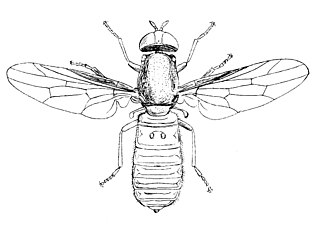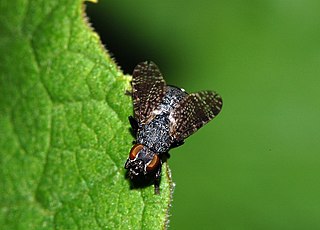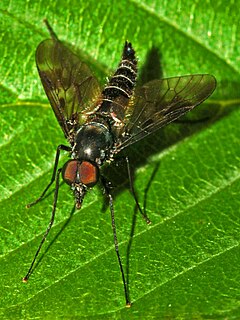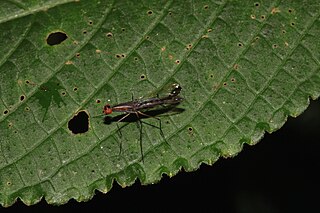
The Piophilidae are a family of "true flies", in the order Diptera. The so-called cheese flies are the best-known members, but most species of the Piophilidae are scavengers in animal products, carrion, and fungi. They may accordingly be important in forensic entomology and medical entomology. For a fly maggot, the larvae of many species have an unusually well-developed ability to leap when alarmed or when abandoning their larval food to pupate; they accordingly may be known as cheese skippers or other kinds of skippers according to their food source.

Crane fly is a common name referring to any member of the insect family Tipulidae, of the order Diptera, true flies in the superfamily Tipuloidea. Cylindrotominae, Limoniinae, and Pediciinae have been ranked as subfamilies of Tipulidae by most authors, though occasionally elevated to family rank. In the most recent classifications, only Pediciidae is now ranked as a separate family, due to considerations of paraphyly. In colloquial speech, crane flies are sometimes known as mosquito hawks or daddy longlegs, a term also used to describe opiliones or the family Pholcidae, both of which are arachnids. The larvae of crane flies are known commonly as leatherjackets.

The Bombyliidae are a family of flies. Their common name are bee flies or humbleflies. Adults generally feed on nectar and pollen, some being important pollinators. Larvae generally are parasitoids of other insects.

The Phoridae are a family of small, hump-backed flies resembling fruit flies. Phorid flies can often be identified by their escape habit of running rapidly across a surface rather than taking to the wing. This behaviour is a source of one of their alternate names, scuttle fly. Another vernacular name, coffin fly, refers to Conicera tibialis. About 4,000 species are known in 230 genera. The most well-known species is cosmopolitan Megaselia scalaris. At 0.4 mm in length, the world's smallest fly is the phorid Euryplatea nanaknihali.

The Conopidae, usually known as the thick-headed flies, are a family of flies within the Brachycera suborder of Diptera, and the sole member of the superfamily Conopoidea. Flies of the family Conopidae are distributed worldwide in all the biogeographic realms except for the poles and many of the Pacific islands. About 800 species in 47 genera are described worldwide, about 70 of which are found in North America. The majority of conopids are black and yellow, or black and white, and often strikingly resemble wasps, bees, or flies of the family Syrphidae, themselves notable bee mimics. A conopid is most frequently found at flowers, feeding on nectar with its proboscis, which is often long.

The Nematocera are a suborder of elongated flies with thin, segmented antennae and mostly aquatic larvae. Major families in the suborder include the mosquitoes, crane flies, gnats, black flies, and a group of families described as midges.

The Asilidae are the robber fly family, also called assassin flies. They are powerfully built, bristly flies with a short, stout proboscis enclosing the sharp, sucking hypopharynx. The name "robber flies" reflects their notoriously aggressive predatory habits; they feed mainly or exclusively on other insects and as a rule they wait in ambush and catch their prey in flight.

The Therevidae are a family of flies of the superfamily Asiloidea commonly known as stiletto flies. The family contains about 1,600 described species worldwide, most diverse in arid and semiarid regions with sandy soils. The larvae are predators of insect larvae in soil.

The Agromyzidae are a family commonly referred to as the leaf-miner flies, for the feeding habits of their larvae, most of which are leaf miners on various plants.

Empididae is a family of flies with over 3,000 described species occurring worldwide in all the biogeographic realms but the majority are found in the Holarctic. They are mainly predatory flies like most of their relatives in the Empidoidea, and exhibit a wide range of forms but are generally small to medium-sized, non-metallic and rather bristly.

The Anisopodidae are a small cosmopolitan family of gnat-like flies known as wood gnats or window-gnats, with 154 described extant species in 15 genera, and several described fossil taxa. Some species are saprophagous or fungivorous. They are mostly small to medium-sized flies, except the genera Olbiogaster and Lobogaster, which are large with bizarrely spatulated abdomens. Their phylogenetic placement is controversial. They have been proposed to be the sister group to the higher flies, the Brachycera. Some authors consider this group to be four distinct families – Anisopodidae, Mycetobiidae, Olbiogastridae, and Valeseguyidae.

The Lonchaeidae are a family of acalyptrate flies commonly known as lance flies. About 500 described species are placed into 9 genera. These are generally small but robustly built flies with blue-black or metallic bodies. They are found, mainly in wooded areas, throughout the world with the exception of polar regions and New Zealand.

The Scenopinidae or window flies are a small family of flies (Diptera), distributed worldwide. In buildings, they are often taken at windows, hence the common name window flies.

The Platystomatidae are a distinctive family of flies (Diptera) in the superfamily Tephritoidea.

Athericidae is a small family of flies known as water snipe flies or ibis flies. They used to be placed in the family Rhagionidae, but were removed by Stuckenberg in 1973. They are now known to be more closely related to Tabanidae. Species of Athericidae are found worldwide.

The family Nothybidae contains only the genus Nothybus, a group of colorful and elongated flies. The family has been recently revised.

Neoitamus cyanurus, the Common Awl Robberfly is a species of 'stiletto flies' belonging to the family Asilidae.

Rainieria calceata is a species of stilt-legged flies belonging to the family Micropezidae.
The Inbiomyiidae are a family of flies first described in 2006. 11 species have been described all in the genus Inbiomyia distributed in the Neotropical region. These are very small, mostly dark flies. The larval biology remains unknown.
Somatia is the sole genus of the acalyptrate brachyceran fly family Somatiidae. The genus includes about seven Neotropical species of small black and yellow flies with a stout and rounded thorax having transverse suture. The legs are separated from the main body by an elongated post-coxal bridge. The broad abdomen is downcurved. The antenna are elbowed with the arista bipectinate. Somatiids resemble members of the Syringogastridae due to the enlarged pronotum and a postcoxal bridge but they have a petiolate abdomen.


















